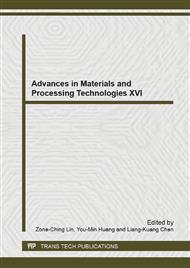[1]
S. Beeby, G. Ensell, M. Kraft, N. White, Editors, MEMS Mechanical Sensors, Artech House, Inc, Boston (2004).
Google Scholar
[2]
F. Vollertsen, H. Schulze Niehoff , Z. Hu, State of the art in microforming, International Journal of Machine Tools and Manufacture 46, (2006), 1172-1179.
DOI: 10.1016/j.ijmachtools.2006.01.033
Google Scholar
[3]
A. Diehl, U. Engel, M. Geiger, Mechanical properties and bending behavior of metal foils. J. Eng. Manuf. 222, (2008), 83–91.
Google Scholar
[4]
R. Eckstein, M. Geiger, U. Engel, Specific Characteristic of Micro Sheet Metal Working, Proceedings of the SheMet, (1999), 529–536.
Google Scholar
[5]
Diehl, A., Engel, U., Merklein, M., Geiger, M., Size effects in bending processes applied to metal foils. Prod. Eng. 4, (2010), 47–56.
DOI: 10.1007/s11740-009-0196-7
Google Scholar
[6]
U. Engel et al., Simulation of microforming processes an advanced appr Tioach applying a mesoscopic model, Proc. of ICTP, CD-ROM, (2005).
Google Scholar
[7]
S. A. Parasiz, R. VanBenthysen, B. L. Kinsey, Deformation size effects due to specimen and grain size in microbending, J. Manuf. Sci. Eng. 132, (2010), 1-8.
DOI: 10.1115/1.4000943
Google Scholar
[8]
L. Hezong, D. Xianghuai, W. Qian, S. Yu, A. Diehl, H. Hagenah, U. Engel, M. Merklein, Determination of material intrinsic length and strain gradient hardening in microbending process, International Journal of Solids and Structures, Volume 48, Issue 1, (2011).
DOI: 10.1016/j.ijsolstr.2010.09.016
Google Scholar
[9]
D. Shan, C. Wang, B. Guo, X. Wang, Effect of thickness and grain size on material behavior in micro-bending, Transactions of Nonferrous Metals Society of China, Volume 19, (2009), s507-s510.
DOI: 10.1016/s1003-6326(10)60098-2
Google Scholar
[10]
J.G. Liu, M.W. Fu, J. Lu, W.L. Chan, Influence of size effect on the springback of sheet metal foils in micro-bending, Computational Materials Science, Volume 50, (2011), 2604-2614.
DOI: 10.1016/j.commatsci.2011.04.002
Google Scholar
[11]
S. A. Parasiz, R. VanBenthysen, B.L. Kinsey, Deformation size effects due to specimen and grain size in bending. J. Manuf. Sci. Eng. 132, (2010), 1-8.
DOI: 10.1115/1.4000943
Google Scholar
[12]
K. Suzuki, Y. Matsuki, K. Masaki, M. Sato, M. Kuroda, Tensile and microbend tests of pure aluminum foils with different thicknesses, Materials Science and Engineering: A, Volumes 513–514, (2009), 77-82.
DOI: 10.1016/j.msea.2009.01.045
Google Scholar
[13]
K. Mori, S. Maki, Y. Tanaka, Warm and Hot Stamping of Ultra High Tensile Strength Steel Sheets Using Resistance Heating, CIRP Annals Manufacturing Technology Volume 54, (2005), 209-212.
DOI: 10.1016/s0007-8506(07)60085-7
Google Scholar
[14]
H. Li, H. Yang, F. F. Song, M. Zhan, G. J. Li, Springback characterization and behaviors of high-strength Ti–3Al–2. 5V tube in cold rotary draw bending, Journal of Materials Processing Technology, Volume 212, (2012), 1973-(1987).
DOI: 10.1016/j.jmatprotec.2012.04.022
Google Scholar


